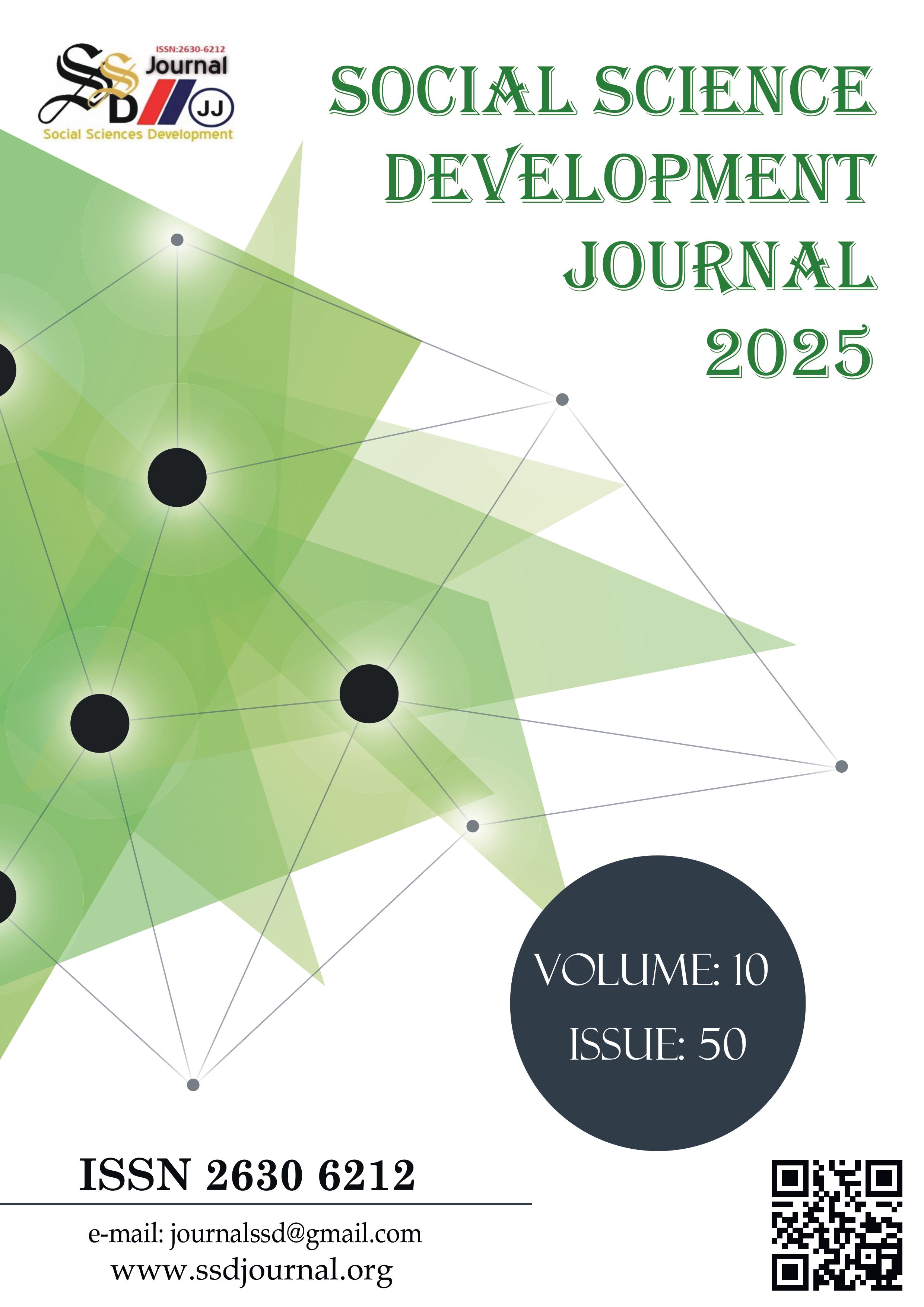MIDWIFERY AND GENDER: A BİBLİOMETRİC ANALYSIS OF PUBLICATIONS BETWEEN 2000 AND 2025
DOI:
https://doi.org/10.5281/zenodo.15929089Keywords:
midwifery, gender, Bibliometric Analysis, Women's HealthAbstract
The aim of this study is to examine the scientific publications in which midwifery and gender concepts are discussed together using bibliometric methods. How the midwifery profession is represented in the context of women's labour, gender roles, power dynamics and care ethics was evaluated through the literature. The data obtained from the Web of Science Core Collection database were evaluated in line with the inclusion and exclusion criteria. In the study, the publication trends of publications on midwifery and gender by years, distribution by countries and keyword frequencies were analysed. It was determined that the publications increased over the years, the most publications were produced in Brazil, South Africa and the United States of America, the researcher who published the most publications was Fonseca Rosa Maria Godoy Serpa Da, and Unıversıdade De Sao Paulo was the institution that published the most publications in this field. Keyword analyses show that the midwifery profession is frequently associated with concepts such as gender roles, women's health and gender equality. In conclusion, it is emphasised that studies on the relationship between midwifery and gender should be increased and academic production in this field will contribute to both the strengthening of the profession and gender equality.
References
Ali, P. (2023). The role of nurses, midwives and healthcare professionals in responding to gender-based violence. Int Nurs Rev,70(4):457-458.
Arias, T., Greaves, B., McArdle, J., Rayment, H., & Walker, S. (2021). Cultivating awareness of sexual and gender diversity in a midwifery curriculum. Midwifery, 101:103050.
Anderson, R., Williams, A., Von Kalm, H., Bazirete, O., Al-Khair, H., Nur, M., & Homer, C. (2023). Global complacency with perpetuation of gender oppression in maternity care pride and gender transformation. Midwifery, 123:103735.
Berkery, E., Tiernan, S., & Morley, M. (2014). The relationship between gender role stereotypes and requisite managerial characteristics: the case of nursing and midwifery professionals. J Nurs Manag. 22(6):707-19.
Bourret, K., Mattison, C., Hebert, E., Kabeya, A., Simba, S., Crangle, M., Darling, E., & Robinson, J. (2023). Evidence-informed framework for gender transformative continuing education interventions for midwives and midwifery associations. BMJ Glob Health, 8(1):e011242.
Coşkun, A.M., Varışoğlu, Y., Koca Çavdar, N., & Kutlu, L. (2022). Relationship between health science students' gender-related attitudes and perception of honor. Perspect Psychiatr Care, 58(3):928-939. doi: 10.1111/ppc.12878. Epub 2021 Jun 6. PMID: 34091904.
Davies, R., & Hanna, P. (2020). The emotional labour of midwives in the context of gendered health care systems. Midwifery, 85, 102704. https://doi.org/10.1016/j.midw.2020.102704
Filby, A., McConville, F., & Portela, A. (2016). What prevents quality midwifery care? A systematic mapping of barriers in low and middle income countries from the provider perspective. PLoS One, 11:e0153391. 10.1371/journalpone.0153391
Hashemzadeh, M., Shariati, M., Mohammad Nazari, A., & Keramat, A. (2021). Childbearing intention and its associated factors: A systematic review. Nurs Open, 8(5):2354-2368.
Karaçam Yılmaz, Z.D., Yılmaz, T., & Tokman, E. (2023). Views of healthcare professionals on gender roles: A qualitative study. Heliyon, (8):e18576. doi: 10.1016/j.heliyon.2023.e18576. PMID: 37560673; PMCID: PMC10407119.
Likis, F.E., & King, T.L. (2020). Gender Diversity and Inclusion in Midwifery. J Midwifery Womens Health, 65(2):193-194.
Lopes, S.C., Titulaer, P., & Bokosi, M. (2015). The involvement of midwives' associations in policy and planning about the midwifery workforce: a global survey. Midwifery, 31:1096–103. 10.1016/j.midw.2015.07.010.
Mattison, C., Bourret, K., & Hebert, E. (2021). Health systems factors impacting the integration of midwifery: an evidence-informed framework on strengthening midwifery associations. BMJ Glob Health, 6:e004850. 10.1136/bmjgh-2020-004850
Mattison, C.A., Bourret, K., & Dion, M.L. (2022). Leveling up evidence syntheses: filling conceptual gaps of the role of midwifery in health systems through a network analysis. BMC Res Notes, 15:216. 10.1186/s13104-022-06094-0
Mattison, C.A., Lavis, J.N., & Wilson, M.G. (2020). A critical interpretive synthesis of the roles of midwives in health systems. Health Res Policy Syst, 18:77. 10.1186/s12961-020-00590-0
Muluneh, M.D., Stulz, V., Francis, L., & Agho, K. (2020). Gender based violence against women in Sub-Saharan Africa: A systematic review and meta-analysis of cross-sectional studies. Int J Environ Res Public Health, 17(3):903.
Peters, M.C.E., Froehlich, M.L., & Zinsser, L.A. (2025). Exploring feminism in midwifery and maternity research: A scoping review. Sex Reprod Healthc, 44:101096. doi: 10.1016/j.srhc.2025.101096. Epub ahead of print. PMID: 40220556.
Saab, M.M. (2023).Transgender and gender diverse youths' experiences of healthcare: A systematic review of qualitative studies. J Child Health Care, 13674935231222054.
Tanna, G.L., & García-Moreno, C. (2021).Training healthcare providers to respond to intimate partner violence against women. Cochrane Database Syst Rev, 5(5):CD012423.
Taylor, J., & Green, L. (2008). Children, health and gender: recognition in nursing research? J Clin Nurs, 17(23):3226-37.
Thomas, E.G., Goodarzi, B., Frese, H., Schoonmade, L.J., & Muntinga, M.E. (2024). Pregnancy experiences of transgender and gender-expansive individuals: A systematic scoping review from a critical midwifery perspective. Birth. DOI: 10.1111/birt.12834
Walsh, D.(2016). Midwives, gender equality and feminism. Pract Midwife. 19(3):24-6. PMID: 27044191.
World Health Organization. (2021). Gender and health. https://www.who.int/health-topics/gender
Wren Serbin, J., & Donnelly, E. (2016). The impact of racism and midwifery's lack of racial diversity: a literature review. J Midwifery Womens Health, 61:694–706. 10.1111/jmwh.12572
Vitale, E., Moretti, L., Notarnicola, A., Di Dio, F., Rifino, F., & Moretti, B. (2020). The authorship in nursing literature: an against trend? Acta Biomed, 91(12-S):e2020005.
Vogel, J.P., Shah, M.G., Fogstad, H., & Langlois, E.V. (2022). Enhancing quality midwifery care in humanitarian and fragile settings: a systematic review of interventions, support systems and enabling environments. BMJ Glob Health, 7(1):e006872.
Yılmaz, T., Dinc Kaya, H., & Günaydın, S.(2021). Evaluation of the Attitudes of Midwifery Students Towards Gender Roles. Soc Work Public Health, 36(7-8):786-794.
Zeidenstein, L. (2007). Midwifery and gender equality. J Midwifery Womens Health, 52(1):1-2.
Zupic, I., & Cater, T. (2015). Bibliometric methods in management and organization. organizational research methods, 18, 429-472.
Downloads
Published
How to Cite
Issue
Section
License
Copyright (c) 2025 Remziye GÜLTEPE

This work is licensed under a Creative Commons Attribution 4.0 International License.



